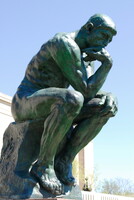| dc.coverage.spatial | Site: The Nelson-Atkins Museum of Art (Kansas City, Missouri, United States) | en_US |
| dc.coverage.temporal | model 1880, cast after 1902 (creation) | en_US |
| dc.creator | Rodin, Auguste | en_US |
| dc.date | 1880-1905 | en_US |
| dc.date.accessioned | 2013-02-27T15:59:05Z | |
| dc.date.available | 2013-02-27T15:59:05Z | |
| dc.date.issued | 1880-1905 | en_US |
| dc.identifier | 197149 | en_US |
| dc.identifier.other | archrefid: 1600 | en_US |
| dc.identifier.uri | http://hdl.handle.net/1721.3/104657 | |
| dc.description | Close side view, showing the viewer's left side; This iconic sculpture is Rodin's most famous work. Originally it was conceived as a portrait of the poet Dante (1265-1321) for a bronze door representing the Gates of Hell in the Decorative Arts Museum, Paris. Over time, it evolved into a more generic image representing all poets or creators. Rodin emphasized the figure's powerful physical presence: "What makes my thinker think is that he thinks not only with his brain, with his knitted brow, his distended and compressed lips, but with every muscle of his arms, back and legs, with his clenched fist and gripping toes." This is one of several full-size bronze casts of The Thinker. Source: Nelson-Atkins Museum of Art [website]; http://www.nelson-atkins.org (accessed 7/5/2008) | en_US |
| dc.format.medium | bronze | en_US |
| dc.rights | © Scott Gilchrist, Archivision, Inc. | en_US |
| dc.subject | allegorical | en_US |
| dc.subject | Nineteenth century | en_US |
| dc.subject | Realist | en_US |
| dc.title | The Thinker | en_US |
| dc.type | image | en_US |
| dc.rights.access | Licensed for educational and research use by the MIT community only | en_US |
| dc.identifier.vendorcode | 6A1-RA-TTKC-A4 | en_US |
| vra.culturalContext | French | en_US |
| vra.technique | casting (process) | en_US |
| vra.worktype | sculpture (visual work) | en_US |
| dc.contributor.display | Auguste Rodin (French sculptor, 1840-1917) | en_US |


